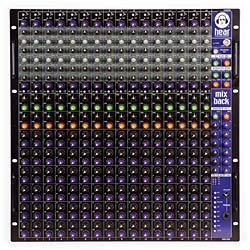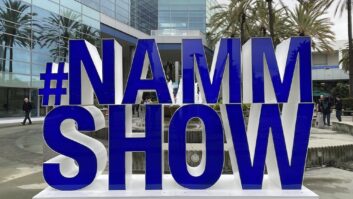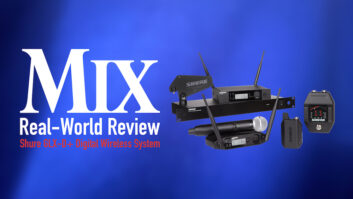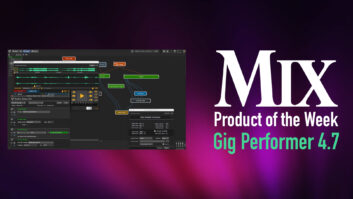
Having trickled down from the rich and famous to the working musician, the continued popularity of in-ear monitors has created a need for high-quality, small-format monitor mixers with multiple output buses. Designed to fill this need, the Hear Technologies Mix Back provides 16 inputs, with 12 mono and two stereo output buses (16×12×2×2) in an 11-rackspace package. This versatile system also can be used for wedge and studio headphone cue applications or even zoned P.A.s.
But this is not just your average mixer. By adding the company’s hub, personal mixers and remote, you can put monitor mix control directly into the hands of the musician and freely communicate to any or all of them from the mixing position.
LET’S HEAR ALL ABOUT IT
Each of the Mix Back’s 16 channels includes rear panel jacks for balanced XLR mic, TRS line in and TRS insert jacks (tip = send, ring = return). A passive split enables each input to be routed through to another console, while ground lift switches on each channel disconnect XLR pin 1 on the output, eliminating ground loops. The split will pass either a line or mic signal, and because it is pre-everything (EQ, gain, insert and faders), the tap is appropriate for sending to a front-of-house console. Phantom power (+18 volts DC) can be applied on a per-channel basis. All outputs are duplicated on ADAT optical and HearBus connectors, either of which can be used to link the Mix Back with the Hear Back hub. (The ADAT optical outs can also be used for recording.)
TRS jacks are provided for the 12 mono and two stereo bus I/Os, as well as for two stereo effect returns, two mono effect sends and a stereo aux input designed to accept what Hear refers to in the Mix Back manual as a “perfect” mix (more on that later). The bus inputs enable you to link multiple units for systems that require more than 16 channels.
On the front are 16 channel strips, each featuring a highpass filter; rotary gain pot (with bi-color LED meter); 4-band EQ with fixed low- and high-shelf, and sweepable mid-bands; pan and level to each of two stereo buses; effects send level with a select switch for send 1 or 2; and level controls for each of 12 mono buses. Effects sends are fixed pre-fader. Given the general static nature of cue mixing, this is probably not an issue, but for applications in which the monitor engineer is constantly tweaking vocal levels or where the Mix Back is used to create an FOH mix, the need to tweak send levels every time a corresponding fader is moved could be annoying. A master section features output masters for each bus, stereo aux-in level, two stereo effect returns, a headphone monitor jack with volume control and input select switches, and a talkback level control.
MAKING IT PERSONAL
Clearly, the Mix Back’s strength comes when used with the HearBus and Hear Back personal mixers. The idea is you create a killer stereo mix of the instruments (whether in a studio control room or from stage inputs). That mix is patched to the Mix Back’s stereo aux in, which merges with the console’s stereo outs (but not its bus outs). The HearBus Ethernet or ADAT optical connection carries the stereo mix and a series of individual signals to the Hear Back hub and out to Hear Back personal mixers (up to eight total), which are under the control of the musicians. The Mix Back remote allows the engineer to pick any or all of the output buses for talkback, enabling communication with any combination of performers without the need to scream over wedge mixes or “sealed” ears — very cool. When the Mix Back is used for zoned P.A., the talkback remote allows public address to be directed only to the required zones.
SOME CAVEATS
If you don’t use the HearBus and Hear Back mixers, then certain limitations apply. The stereo aux-in feeds only the two stereo buses, so you’ll have to patch your “perfect mix” into a pair of channels to send it to all 12 mix buses. Effect returns feed only the stereo buses, so you can’t route effects directly to buses 1 through 12. Although the manual suggests that the Mix Back can be used for conventional wedge mixing, there are a few things to mention: There is no rear panel output for a monitor engineer’s cue wedge, so you’ll have to use the ‘phones output as a feed to a power amp for the cue wedge. Also, the mixes can be cued only in pairs. For example, there’s no way of listening only to mix 3 because it’s paired with mix 4 in the monitor-select switch. Lastly, there is no PFL or solo for the channels, making the process of isolating a single channel a major production. You’ll have to use one of the mix buses as an engineer’s cue and then turn off all the other channels in that mix.
A CLEAN MACHINE
The Mix Back’s signal path is very clean, with tons of headroom in the mic pre. The highpass filter (100 Hz) is especially useful on vocal mics, where it removed just about any sort of low-frequency crud you could imagine while somehow managing not to alter the sound of a male vocal. Although the high- and low-EQ bands are fixed (shelf), the mid-bands overlap by about 2.5 octaves, so the EQ can do anything you’ll need. I especially liked what the low-shelf boost did for kick drum, and the way the high shelf brightened up acoustic guitar.
EQ is applied pre-fader, so any changes in channel EQ will be heard on all output buses. The Mix Back provides +18V DC for the phantom supply, so some condenser mics will not operate properly. Shure SM98, Sony C535 and C48, Neumann KM84 and DPA 4015 worked fine; Neumann U87, Earthworks TC25, Audio-Technica AT4050 and Audix SCX25 did not.
THE SCORE
Even though the Mix Back packs a ton of control into a relatively small space, all of its functions are clearly labeled, easy to access and logically organized. Buses 1 through 12 are laid out in pairs for easy stereo mixing to ear monitors, and the remote talkback is a home run — especially in applications involving zoned P.A.s where local paging is required or in situations where a monitor engineer may need to “target” private communication with certain members of a band throughout the course of a performance. Metering is sparse but functional, and Hear Technologies includes a UV gooseneck lamp that cleverly illuminates the knob pointers so that once the lights go down, all mixes are clearly visible.
On the downside, the fixed pre-fader effects sends and phantom power might be an issue, and some creative signal routing may be required to get the stereo effects returns into the outputs of buses 1 through 12. The Mix Back’s quick-start guide implies that the unit is a solution to every P.A. requirement when it is not. However, it is the nucleus for an incredibly flexible, high-quality monitoring system and can be used for a house mix in a pinch. To take full advantage of Mix Back’s abilities, you’ll need to add the Hear Back personal mixers, which turns the system into a powerhouse for in-ear monitoring or studio cue mixing.
Prices: Mix Back Mixer, $2,495; personal mixer, $229.95; hub, $579; and remote, $139.95.
Hear Technologies, 256/922-1200, www.heartechnologies.com.







